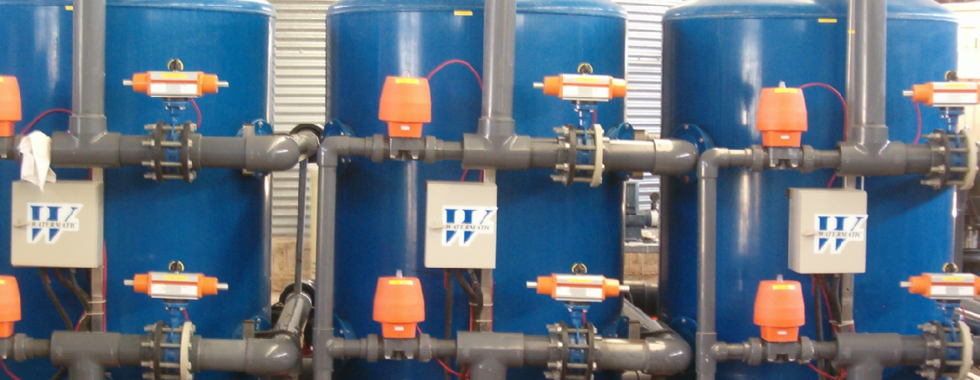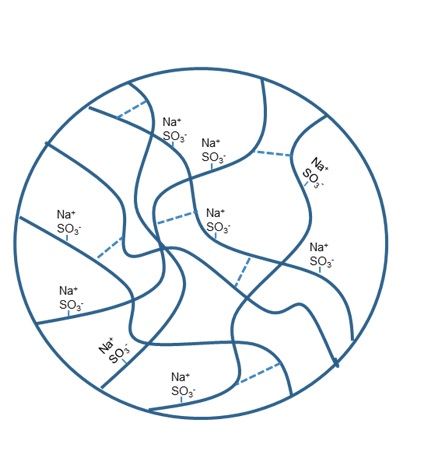Ion exchange
Ion exchange is a water treatment process used to remove undesirable ions from water and replace them with other, desirable ions.
The applications of ion exchange in water and wastewater treatment include:
- Removal of Ca and Mg hardness
- Removal of Fe, Mn from groundwater
- Removal of heavy metals and organic pollutants
- Demineralization – removal of all dissolved solids
- Nutrient removal – NO3, NH4, PO4
The most common application is water softening, or hardness removal, where calcium and magnesium that are present in the water, are replaced by sodium.
HOW DOES ION EXCHANGE WORK?
In ion exchange, the water flows through an insoluble media that can exchange ions with the water.
The media is usually a synthetic polymer resin. Polymeric ion exchange resins are composed of
a crosslinked polymer matrix that contains charged functional groups, which are fixed to the polymer chain. The resin is being saturated with counter-charged ions, which are mobile and exchangeable.
Ions in the water are replaced by counter ions adsorbed to the resin and are therefore, removed.
In ion exchange adsorption, the replacement of an ion in the solution by an ion on the resin surface is on 1:1 charge basis.
TYPES OF ION EXCHANGE RESINS
There are two types of ion exchange materials:
- Cation exchange materials (+) – replace positively charged ions in the water with other presaturant, positively charged ions.
- Anion exchange materials (-) – replace negatively charged ions in the water with other presaturant, positively charged ions.
Resin types can be further divided to four groups:
- Strong-acid cation exchange resin – can remove any cation from the water, if the persaturant is H+, and divalent ions if the presaturant is sodium (Na+).
- Weak-acid cation exchange resin – the fixed group that creates the exchange site is a carboxylic group. They are used mainly for removal of alkalinity and some unique applications.
- Strong-base anion exchange resin – when the presaturant ion is OH–, they can remove any anion.
- Weak-base anion exchange resin
SELECTIVITY OF ION EXCHANGE RESINS
Each resin has different affinity (“preference”) to certain ions.
The selectivity depends on:
- The properties of the resin – distribution of pore size, type of functional group etc.
- The properties of the exchanging ion – valence, hydrated radius.
Smaller hydrated radius – greater affinity. - Percent of cross links.
The selectivity of common resins follows the following series.
Cation Exchange:
H+ <Li+ <Na+ <NH4+ <K+ <Cs+ <Ag+ <Mg2+ <Zn2+ <Cu2+ <Cd+ <Ni+ <Ca+ <Sr+ <Pb2+ <Ba2+ <Y3+ <La3+
For example, H+ adsorbed to the resin will be exchanged by any other cation, potassium (as the presaturant ion) will be exchanged by calcium, i.e. remove calcium, but a resin saturated by potassium will not be able to remove sodium from the water.
Anion exchange:
OH– ≈F– <Cl– <Br– <MoO42- <PO42- <AsO43- <NO3– <CrO42- <SO42-
For example, OH adsorbed to the resin will be exchanged by any other anion.
EXCHANGE CAPACITY
The maximum number of ions that the resin can exchange before regeneration is necessary. It is expressed as milliequivalents per milliliter of resin or kg per cubic foot of CaCO3, where 1 kg/ft3 = 21.8 meq/ml.
Column capacity is defined as – C * XA * Vresin
Where C is the resin exchange capacity, XA is the fraction of sites that can be occupied by the specific ion and Vresin is the volume of the resin.
REGENERATION OF THE ION EXCHANGE COLUMN
The ion exchange has to be regenerated once the resin is exhausted and, in case of water softening, hardness breaks through.
Regeneration is done with brine, usually with a concentration of 10% .
During the regeneration, the presaturant ion adsorbs to the resin, replacing the ion that has been removed.
The time required for regeneration is usually 20-40 minutes.







